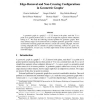Free Online Productivity Tools
i2Speak
i2Symbol
i2OCR
iTex2Img
iWeb2Print
iWeb2Shot
i2Type
iPdf2Split
iPdf2Merge
i2Bopomofo
i2Arabic
i2Style
i2Image
i2PDF
iLatex2Rtf
Sci2ools
DMTCS
2010
2010
Edge-Removal and Non-Crossing Configurations in Geometric Graphs
A geometric graph is a graph G = (V, E) drawn in the plane, such that V is a point set in general position and E is a set of straight-line segments whose endpoints belong to V . We study the following extremal problem for geometric graphs: How many arbitrary edges can be removed from a complete geometric graph with n vertices such that the remaining graph still contains a certain non-crossing subgraph. The noncrossing subgraphs that we consider are perfect matchings, subtrees of a given size, and triangulations. In each case, we obtain tight bounds on the maximum number of removable edges.
Certain Non-crossing Subgraph | Complete Geometric Graph | DMTCS 2010 | Geometric Graph | Sensor Networks |
| Added | 02 Mar 2011 |
| Updated | 02 Mar 2011 |
| Type | Journal |
| Year | 2010 |
| Where | DMTCS |
| Authors | Oswin Aichholzer, Sergio Cabello, Ruy Fabila Monroy, David Flores-Peñaloza, Thomas Hackl, Clemens Huemer, Ferran Hurtado, David R. Wood |
Comments (0)

